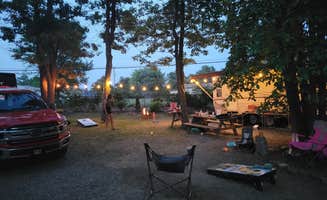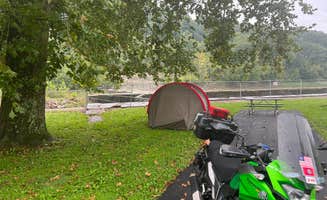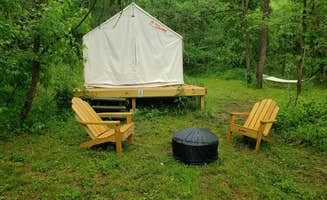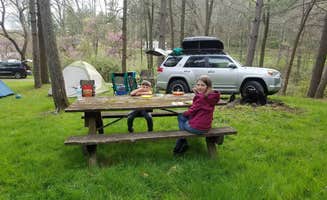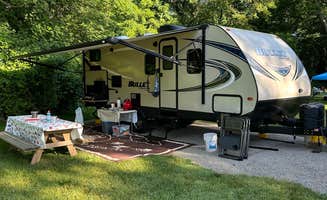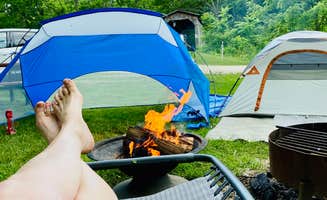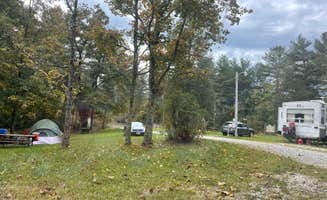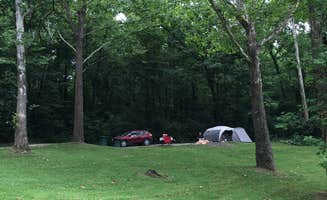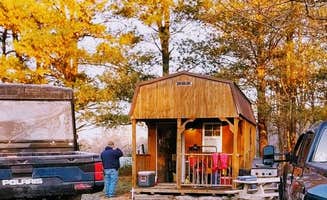Zanesville camping sites sit within rolling hills of southeastern Ohio's Appalachian Plateau, typically ranging 800-1,000 feet above sea level. The area receives approximately 39 inches of rainfall annually, creating lush surroundings but occasionally challenging camping conditions after heavy precipitation. Winter temperatures regularly drop below freezing between November and March, making seasonal camping restrictions common throughout the region.
What to do
**Wildlife observation: Dillon State Park Campground offers extensive deer watching opportunities. "The deer are plentiful and beautiful," notes Andrea H. The park's heavily forested areas provide natural habitat for various wildlife species accessible from camping areas.
Fishing in stocked ponds: National Road Campground maintains two ponds in the center of the grounds stocked with fish. Terry F. mentions, "The ponds are stocked with fish and because it is private land no fishing license is required." This makes it convenient for campers wanting quick fishing access without purchasing additional permits.
Hiking trail access: Beyond water recreation, campers can explore marked trails throughout the region's parks. According to Ryan W. at Blue Rock State Park Campground, "The hiking was wonderful, the equestrian trails looked very nice, and the fire tower was a fun climb." The park's trail system accommodates both casual walkers and more serious hikers.
What campers like
Salt water pool facilities: Several private campgrounds offer swimming alternatives to lake recreation. At Wolfie's Campground, Theresa notes there's a "Small salt water pool, game room and playground keep kids busy. A little piece of paradise." These facilities provide swimming options when lake conditions are unfavorable.
Secluded camping sections: Many campers appreciate finding quieter areas within larger campgrounds. John L. recommends at Dillon State Park Campground, "Go to the back of the campground. It is very quite." Similarly, sites in Area C are noted as the most secluded area according to reviewers.
Affordable cabin alternatives: For those seeking shelter beyond tent or RV camping, cabins provide economical options. Renée C. shares about Dillon State Park, "Great place to rent a cabin! Inexpensive and always a pleasant stay." These structures offer protection from unpredictable weather without resort-level pricing.
What you should know
Bathroom facility variability: Campground restroom quality varies significantly throughout the region. Nicole C. notes about Blue Rock State Park Campground, "The only negative was no flush toilets, only pits and no sink to wash hands, but there was hand sanitizer at least." Some parks maintain newer facilities while others use older pit toilets.
Campsite leveling challenges: Many sites across the region require equipment for leveling. Gary O. observes at Dillon State Park, "Many sites are not level. Many sites have NO shade. Only Electric available at each site." Preparation with leveling blocks is advisable.
Limited cell service: Connectivity remains spotty throughout camping areas near Zanesville. Campgrounds in more remote locations typically have minimal to no cellular reception, particularly in valleys and heavily wooded areas.
Tips for camping with families
Kid-friendly water features: Beyond swimming areas, some campgrounds provide specialized water activities. Jordan N. mentions at National Road Campground, "We enjoyed fishing as well as watching our child on the playground and splash pad!" These additional water features entertain children when swimming isn't practical.
Wildlife education opportunities: Several parks offer naturalist programs during peak season. Ryan W. found at Blue Rock State Park that "the activities with the naturalist (Cayden) were fun and engaging," providing structured learning opportunities about local ecosystems.
Creek exploration for children: Sites with shallow water access offer safe nature interaction. Ryan W. also notes at Blue Rock that "There is a creek running through the main primitive campsites below the dam, with minnows and crawfish for the kids to catch," creating natural entertainment without extensive planning.
Tips from RVers
Site selection strategy: When possible, investigate campground layout before selecting sites. Brian B. advises at Dillon State Park Campground, "Area C is the most secluded area. All RV sites have 50A/30A electric. Limited sites have full hook-up." Researching specific site locations improves camping experience.
Water access planning: RVers should note water spigot locations when choosing sites. Linda B. cautions, "We were by a water spout and every time an RV/Trailer came in they of course had to fill up. Check a campground map and try to avoid these sites." High-traffic water access points create consistent disturbance.
Off-season accommodation: Some campgrounds maintain limited year-round availability for RVs. Steve E. at Wolfie's Campground notes the entrance can be challenging: "The only challenge is you don't want to meet a rig going out while you're coming in." Winter campers should call ahead for specific site accessibility.


